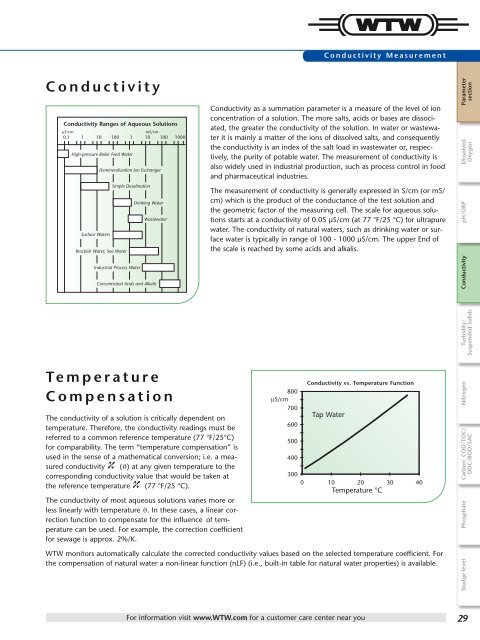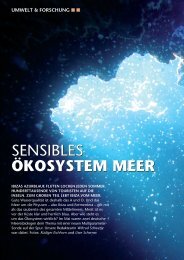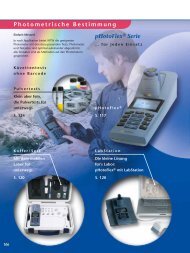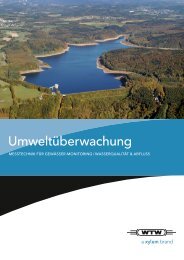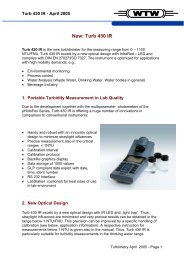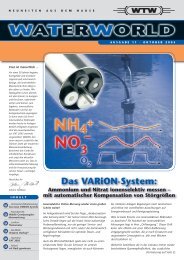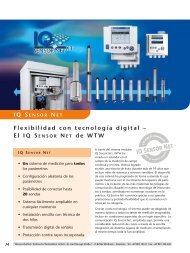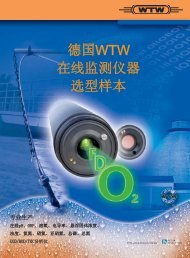Online Instrumentation - WTW.com
Online Instrumentation - WTW.com
Online Instrumentation - WTW.com
Create successful ePaper yourself
Turn your PDF publications into a flip-book with our unique Google optimized e-Paper software.
Conductivity<br />
Conductivity Ranges of Aqueous Solutions<br />
µS/cm mS/cm<br />
0.1 1 10 100 1 10 100 1000<br />
High-pressure Boiler Feed Water<br />
Surface Waters<br />
Demineralization lon Exchanger<br />
Brackish Water, Sea Water<br />
Simple Desalination<br />
Industrial Process Water<br />
Drinking Water<br />
Wastewater<br />
Concentrated Acids and Alkalis<br />
Temperature<br />
Compensation<br />
The conductivity of a solution is critically dependent on<br />
temperature. Therefore, the conductivity readings must be<br />
referred to a <strong>com</strong>mon reference temperature (77 °F/25°C)<br />
for <strong>com</strong>parability. The term “temperature <strong>com</strong>pensation” is<br />
used in the sense of a mathematical conversion; i.e. a measured<br />
conductivity (ϑ) at any given temperature to the<br />
corresponding conductivity value that would be taken at<br />
the reference temperature (77 °F/25 °C).<br />
The conductivity of most aqueous solutions varies more or<br />
less linearly with temperature ϑ. In these cases, a linear correction<br />
function to <strong>com</strong>pensate for the influence of temperature<br />
can be used. For example, the correction co efficient<br />
for sewage is approx. 2%/K.<br />
For information visit www.<strong>WTW</strong>.<strong>com</strong> for a customer care center near you<br />
Conductivity Measurement<br />
Conductivity as a summation parameter is a measure of the level of ion<br />
concentration of a solution. The more salts, acids or bases are dissociated,<br />
the greater the conductivity of the solution. In water or wastewater<br />
it is mainly a matter of the ions of dissolved salts, and consequently<br />
the conductivity is an index of the salt load in wastewater or, respectively,<br />
the purity of potable water. The measure ment of conductivity is<br />
also widely used in industrial production, such as process control in food<br />
and pharma ceutical industries.<br />
The measurement of conductivity is generally expressed in S/cm (or mS/<br />
cm) which is the product of the conductance of the test solution and<br />
the geometric factor of the measuring cell. The scale for aqueous solutions<br />
starts at a conductivity of 0.05 µS/cm (at 77 °F/25 °C) for ultrapure<br />
water. The conductivity of natural waters, such as drinking water or surface<br />
water is typically in range of 100 - 1000 µS/cm. The upper End of<br />
the scale is reached by some acids and alkalis.<br />
800<br />
µS/cm<br />
700<br />
<strong>WTW</strong> monitors automatically calculate the corrected conductivity values based on the selected temperature coefficient. For<br />
the <strong>com</strong>pensation of natural water a non-linear function (nLF) (i.e., built-in table for natural water properties) is available.<br />
600<br />
500<br />
400<br />
Conductivity vs. Temperature Function<br />
Tap Water<br />
300<br />
0 10 20 30 40<br />
Temperature °C<br />
Parameter<br />
section<br />
Conductivity pH/ORP Dissolved<br />
Oxygen<br />
Nitrogen Turbidity/<br />
Suspended Solids<br />
Sludge level Phosphate Carbon: COD/TOC/<br />
DOC/BOD/SAC<br />
29


